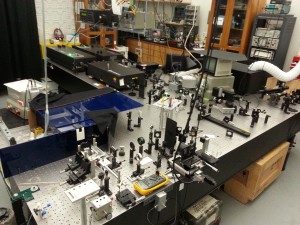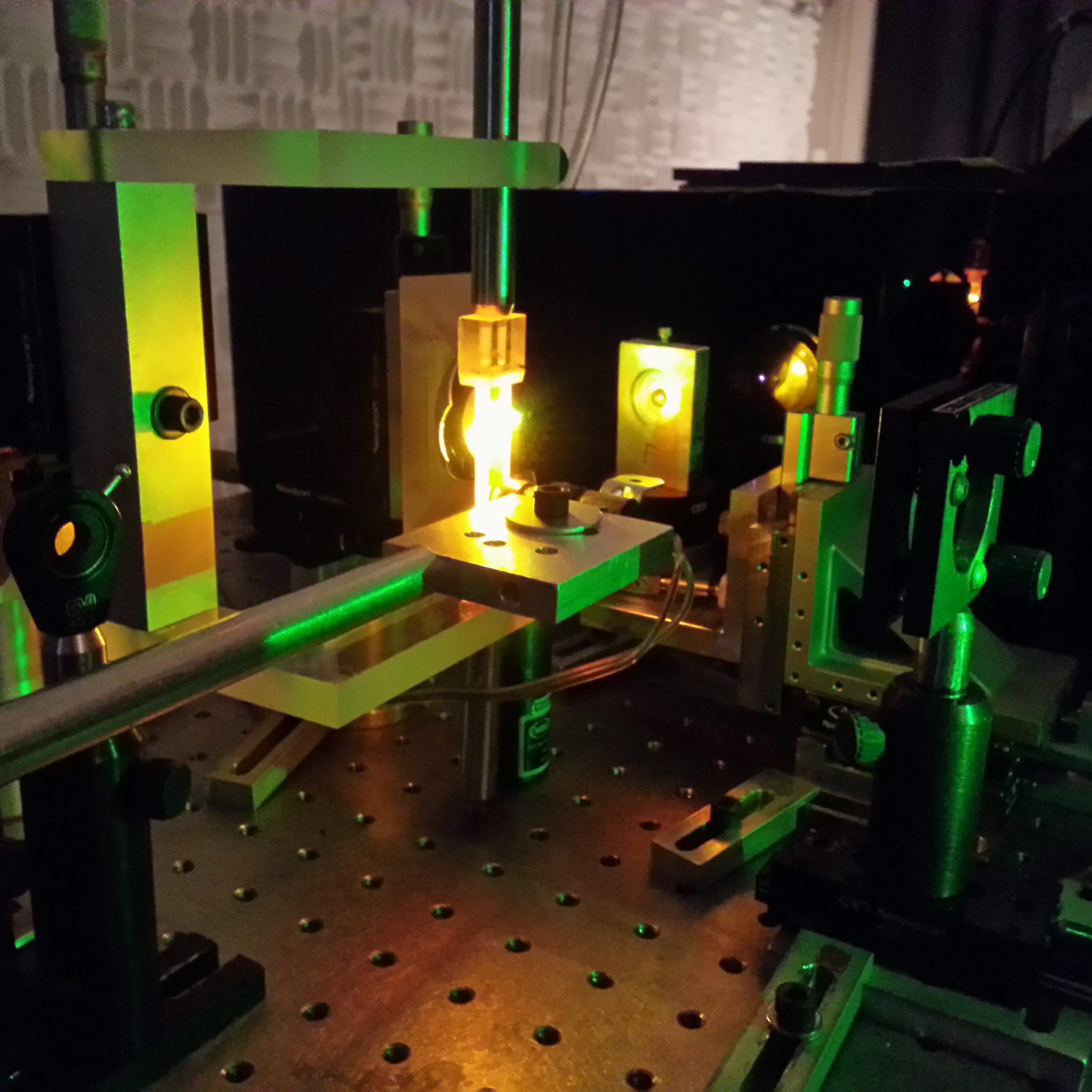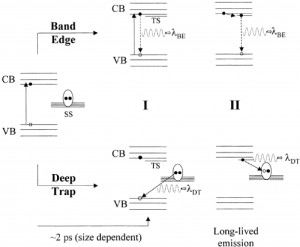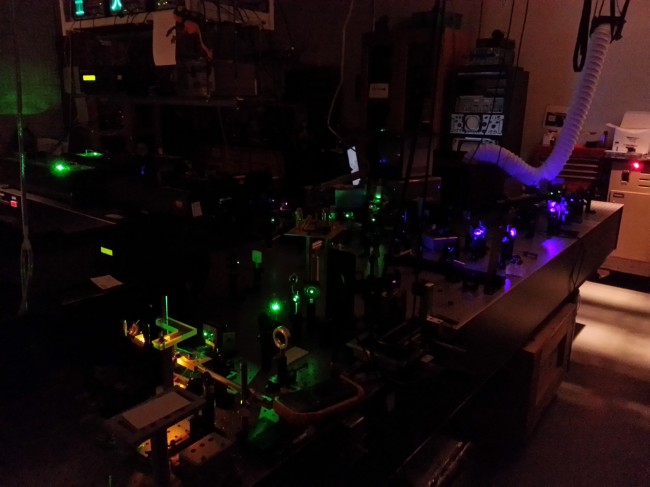
Our ultrafast titanium:sapphire laser system is a commercial system from Coherent, Inc. It consists of a Verdi V-18 laser which pumps a mode-locked Ti:sapphire laser (Mira 900 Basic), Regenerative Amplifier (RegA 9000) and Optical Parametric Amplifier (OPA 9400). The OPA gives us the ability to produce wavelengths from 400 nm to ~2000 nm by combining the signal, idler, and residual second harmonic pump source.
The experiment itself is probably the most intuitive of the ultrafast laser spectroscopic techniques. The data comes in the form of fluorescence with respect to time, which is analogous to what most commercial fluorimeters would call a kinetics script for observing fluorescence intensity with time. The major difference between the two is that instead of time of observation being counted in minutes, seconds or even milliseconds, we observe fluorescence on the femtosecond (10-15 seconds) time scale.

Typical fluorescence upconversion data appears as a sum of decaying exponentials, with the caveat that the shape of the laser pulse must be taken into account. This is necessary because the laser pulse duration is nearly on the order of the time constants for the decay of the fluorescence intensity. The data fitting function is therefore a convolution of a function representing the laser pulse (in our case a Gaussian) and a sum of decaying exponentials.
In quantum dots, high surface-to-volume ratios coupled with the strong geometric confinement of the exciton lead to significant interaction of excited charge carriers with the surface of the nanocrystal. These surface interactions occur on the femto- and picosecond time scale directly after excitation and dictate the ultimate fate of the excited state. Any charge carriers that become trapped at surface or internal defect states become localized and cannot radiatively recombine to emit a photon. Since the experiment monitors fluorescence from the nanocrystals, charge carrier trapping is realized as a decrease in fluorescence intensity as a function of time. Utilizing fluorescence upconversion spectroscopy, we are able to monitor the fluorescence intensity from the nanocrystals with <250 fs temporal resolution. Additionally, we can monitor specific wavelengths in the emission spectrum from the nanocrystals which allows us to preferentially probe the excited state at the band edge.


Selected Publications
Keene, J. D.; McBride, J. R.; Orfield, N. J.; Rosenthal, S. J., Elimination of Hole-Surface Overlap in Graded CdSxSe1-x Nanocrystals Revealed By Ultrafast Fluorescence Upconversion Spectroscopy. ACS Nano 2014, 8 (10), 10665-10673.
Bowers, M. J., II; McBride, J. R.; Garrett, M. D.; Sammons, J. A.; Dukes, A. D., III; Schreuder, M. A.; Watt, T. L.; Lupini, A. R.; Pennycook, S. J.; Rosenthal, S. J., Structure and Ultrafast Dynamics of White-Light-Emitting CdSe Nanocrystals. J. Am. Chem. Soc. 2009, 131 (16), 5730-5731.
Garrett, M. D.; Bowers, M. J., II; McBride, J. R.; Orndorff, R. L.; Pennycook, S. J.; Rosenthal, S. J., Band Edge Dynamics in CdSe Nanocrystals Observed by Ultrafast Fluorescence Upconversion. J. Phys. Chem. C 2008, 112 (2), 436-442.
Garrett, M. D.; Dukes, A. D., III; McBride, J. R.; Smith, N. J.; Pennycook, S. J.; Rosenthal, S. J., Band Edge Recombination in CdSe, CdS and CdSxSe1-x Alloy Nanocrystals Observed by Ultrafast Fluorescence Upconversion: The Effect of Surface Trap States. J. Phys. Chem. C 2008, 112 (33), 12736-12746.
Kippeny, T. C.; Bowers, M. J., II; Dukes, A. D., III; McBride, J. R.; Orndorff, R. L.; Garrett, M. D.; Rosenthal, S. J., Effects of surface passivation on the exciton dynamics of CdSe nanocrystals as observed by ultrafast fluorescence upconversion spectroscopy. J. Chem. Phys. 2008, 128 (8), 084713/1-084713/7.
Underwood, D. F.; Kippeny, T.; Rosenthal, S. J., Ultrafast Carrier Dynamics in CdSe Nanocrystals Determined by Femtosecond Fluorescence Upconversion Spectroscopy. J. Phys. Chem. B 2001, 105 (2), 436-443.

